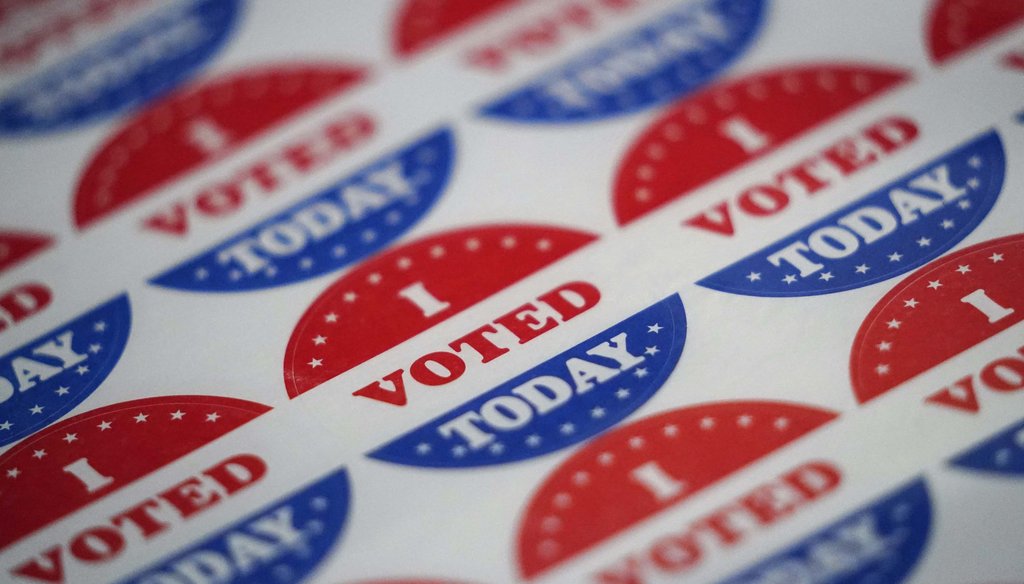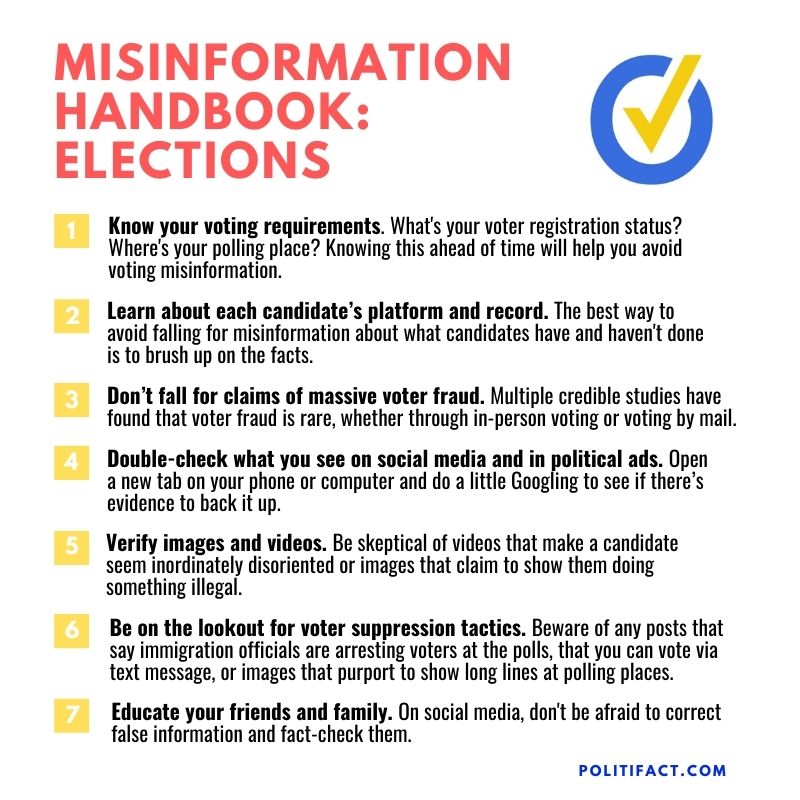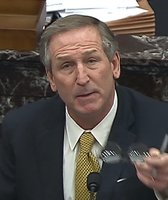Stand up for the facts!
Our only agenda is to publish the truth so you can be an informed participant in democracy.
We need your help.
I would like to contribute

Vote stickers are seen at a satellite election office at Temple University's Liacouras Center on Sept. 29, 2020, in Philadelphia. (AP)
As Election Day approaches, you may be more likely to see online disinformation that’s aimed at influencing your vote.
This year, we’ve fact-checked dozens of false claims on social media about the candidates. Other events — the coronavirus pandemic, nationwide protests against police brutality and natural disasters — have created an even more fertile environment for misinformation to spread.
"Avoiding this is tough — anyone who actively consumes the news in 2020, and particularly social media, will encounter some misinformation," said Brendan Nyhan, a government professor at Dartmouth College.
With that in mind, we’ve created a guide with seven ways to avoid falling for false election-related information between now and Nov. 3. Have a tip you want us to add or a post you want us to fact-check? Email [email protected].
Download the image below to share an abbreviated version of this guide on social media.
1. Know your voting requirements
One of the best ways to protect yourself against misinformation is to arm yourself with factual information. When it comes to elections, knowing basic facts about the voting process can be the best way to avoid falling for disinformation.
"Be really discerning about where you’re getting information about voting," said Jessica Weeks, a political science professor at the University of Wisconsin-Madison. "Figure out who in your county is administering the election and follow their official account. Go straight to the source for those kinds of questions."
Prioritize primary sources, such as your county’s elections supervisor, when seeking information about your voter status. If you can’t find any, try using Vote.org, FiveThirtyEight’s election guide, or USA.gov. Those resources let you check your voter registration status, request an absentee or mail-in ballot, find your polling place, and even get reminders for when and how to vote. They also include specific voting rules based on what state you live in.
Get acquainted with this information before Election Day so you’ll be less likely to fall for misinformation at the last minute.
2. Learn about each candidate’s platform and record
Some of the most popular campaign-related claims are related to candidates’ records and what policies they support. The best way to avoid falling for misinformation about those points is to brush up on some basic facts.
PolitiFact has published guides to candidate positions for both Joe Biden and Donald Trump. We’ve also published updates on President Donald Trump’s 2016 campaign promises. Ballotpedia has more information about the careers and political backgrounds of both national and local candidates. If candidates have been in Congress before, Congress.gov lets you search for how politicians have voted on specific bills.
Finally, don’t forget to actually read the official campaign platform of each candidate. That way, you can see for yourself what exactly they are advocating for and against.
3. Don’t fall for claims of massive voter fraud
You may have heard President Trump or others say that this election will be marred by widespread voter fraud. But the evidence for rampant voter fraud is scant.
RELATED: PolitiFact's coverage of Election 2020
"The most worrisome form of political misinformation right now are unsupported claims that the election is fraudulent or rigged or going to be stolen," Nyhan said. "These are baseless accusations, and amplifying them is particularly dangerous."
Multiple credible studies have found that voter fraud is rare, whether through in-person voting or voting by mail. There have been only a handful of confirmed incidents over the past few years. Mail ballots pose a slightly higher risk of fraud than voting in person, but there’s no evidence to support claims of widespread election rigging.
4. Double-check what you see on social media and in political ads
Knowing the facts about voting will only get you so far in the world of online misinformation. It’s important that you also take the time to double-check claims you see in your social media feeds and in political advertisements.
"The best thing we can do when we’re looking at content on our social media feeds and on websites is to take a breath, pause, do an investigation of the source of the information," said Cindy Otis, a disinformation expert and former CIA officer. "This is just the time where we really need to slow down in terms of the pace with which we’re sharing things."
Instead of taking political claims or attacks at face value, open a new tab on your phone or computer and do a little Googling to see if there’s evidence to back it up. Look for context from independent fact-checking outlets or, better yet, find a primary source that confirms or refutes the claim. When in doubt, don’t share something if you’re not 100% sure it’s true.
5. Verify images and videos
PolitiFact has fact-checked several misleading, false or manipulated photos and videos that aim to discredit both presidential candidates. But how can you verify something you saw on social media if a fact-checker hasn’t covered it?
In general, be skeptical of videos that make a candidate seem disoriented, incapacited or drunk, as well as images that claim to show them doing something illegal. When in doubt, use tools like Google Reverse Image Search and InVid to find the original context of visuals you see on social media. (It’s as easy on some devices as a right click.)
RELATED: 10 tips for verifying viral social media videos
Beware of out-of-context quotes, which are one of the most common types of misinformation. Don’t immediately trust one candidates’ attacks on the other until you’ve verified the facts.
6. Be on the lookout for voter suppression tactics
Closer to Election Day, we tend to see more claims about how, where and when to vote. This year, many of those claims could be part of disinformation aimed at suppressing the vote in certain parts of the country.
Beware of any posts that say immigration officials are arresting voters at the polls; that you can vote via text message; or that voting machines are malfunctioning. Those are all examples of falsehoods that spread on Election Day in 2018 and 2016. Sometimes images of long lines are used to distort the truth and discourage turnout, too.
RELATED: What we know about 2020 election interference: It’s not just Russia
Keep in mind that in-person voting for the general election is Tuesday, Nov. 3. (Voting will not be spread across two days). Be sure to create a plan ahead of time — research the candidates, request time off, decide how and where you will cast your ballot — so you won’t be swayed by manipulation tactics.
If you’re voting by mail, read all instructions carefully so there are not mistakes that might disqualify your ballot. Make sure to allow enough time for your ballot to arrive at election offices on time.
7. Educate your friends and family
If you’ve read this far, you probably have a fairly good idea of how to avoid misinformation in the weeks leading up to Election Day. But your friends and family may not.
"People that want the election to go fairly and watch out for meddling should be reaching out to people who are less politically sophisticated to make sure they’re getting accurate information," Weeks said.
Research shows that, in general, people tend to accept corrections from people they know more than people they don’t. If someone in your life shares misinformation on social media, don’t be afraid to fact-check them. If you want to correct them, be sure to do it in a friendly way. (Here are a few ideas for how to go about doing that.)
Misinformation aside, check in with people you care about to see how they’re preparing to vote in this election. Ask them if they’re sure that they’re registered and whether they have a plan for how to vote during the pandemic. If you’re shy, try using your social media accounts to promote information about voter registration deadlines, how to request mail-in ballots and where to vote in person on Election Day.
"I think actually people can play a positive role in their own circles," Nyhan said. "Everyone is an influencer among their friends and family."
RELATED: A voters’ guide to combating misinformation ahead of the election and beyond
Our Sources
Ballotpedia, accessed Oct. 5, 2020
Congress.gov, accessed Oct. 5, 2020
DonaldJTrump.com, accessed Oct. 5, 2020
FiveThirtyEight, "How To Vote In The 2020 Election," Oct. 5, 2020
Harvard Kennedy School Misinformation Review, "Prebunking interventions based on ‘inoculation’ theory can reduce susceptibility to misinformation across cultures," Feb. 3, 2020
The Heritage Foundation, Election Fraud Cases, accessed Oct. 5, 2020
Interview with Brendan Nyhan, government professor at Dartmouth College, Sept. 30, 2020
Interview with Cindy Otis, former CIA officer and a disinformation and cybersecurity expert, Sept. 18, 2020
Interview with Jessica Weeks, political science professor at the University of Wisconsin-Madison, Sept. 18, 2020
JoeBiden.com, accessed Oct. 5, 2020
The New York Times, "6 Types of Misinformation to Beware Of on Election Day. (And What to Do if You Spot Them.)" Nov. 5, 2018
PolitiFact, "Bios of the Democratic presidential candidates," June 14, 2019
PolitiFact, "Donald Trump’s dubious claim that 'thousands' are conspiring on mail-ballot fraud," April 9, 2020
PolitiFact, "Edited video of Joe Biden stuttering on The View was meant as satire," May 28, 2020
PolitiFact, "Here’s how to fact-check your family at the Thanksgiving dinner table," Nov. 25, 2019
PolitiFact, "How to fact-check coronavirus misinformation on your timeline," May 22, 2020
PolitiFact, "Misleading clip of Trump appearing disoriented on White House lawn was deceptively edited," Sept. 8, 2020
PolitiFact, Trump-O-Meter, accessed Oct. 5, 2020
Poynter, "Study: On Twitter, you’re better off fact-checking your crazy uncle than a complete stranger," Sept. 11, 2017
Science, "Inoculating against misinformation," Dec. 1, 2017
Snopes, "Voting Split Across Two Days," Oct. 31, 2000
USA.gov, accessed Oct. 6, 2020
Vote.org, accessed Oct. 5, 2020

































